2017
2016
2015
| 3) 笄 春花図 銘 夕秀舎一至 Design: Spring flowers design on the Shakudo-nanako ground. SOLD |
||||
|
||||
| 横155.0 (mm) 本名を橋本玄治といい、文政3年(1820)に京都で生まれる。名工『後藤一乗』の門人で、嘉永 3年(1850)、30歳で師より『一』の字をもらい一至の工名を許された。桜や土筆などが細かく 描かれており春を感じさせてくれる。裏地に金が使われた贅沢な逸品。明治29年(1896)没。 江戸時代後期。保存鑑定書付。 Design of spring flowers, cherry blossoms and horsetails made by Hashimoto Isshi (1820-1896) who is a representative pupil of great metal worker, Goto Ichijo. The cherry blossoms and horsetails are depicted on the Shakudo ground in fine details. This elegant Kogai create an atmosphere of breath of spring well. 19th century. Hozon certificate paper. |
||||
| 4)鐔 吉野川透図 銘 筑前住雅常作 平成八年初春 (1996年) Design of the Yoshino River by a modern artisan, Sakamoto Masatsune SOLD |
||||
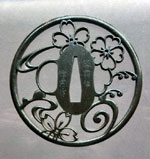 |
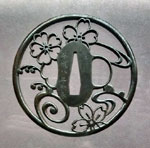 |
|||
| 寸法:縦78.5×横78.5×厚さ5.0 (mm) 解説:桜の名所として名高い吉野の風景を題材にした、坂本雅常による現代金工作。 川岸に舞う桜花を、透かし技法で勢いかつ丁寧に仕上げている。平成8年制作。 A modern work of art in the early spring of 1996 by Sakamoto Masatsune in Chikuzen (now Fukuoka pref.). The Yoshino River in Nara is famous scenery to enjoy cherry blossoms. The whirling blossoms at the riverside are depicted with openwork technique carefully, and it will give people peace of mind. |
||||
2014
| 2) 鐔 桜花網代図 Design: Cherry blossoms and Japanese traditional net. 18c. Sold |
|
book2.html へのリンク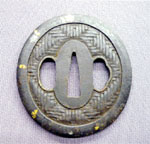 |
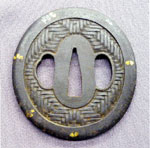 |
| 2) 鐔 桜花網代図 縦74.5×横70.0×厚さ4.5 (mm) 網代模様を入念に施し、周りの鉄地に桜花金銀象嵌を表裏に散りばめている。 無銘だが手の込んだ仕上がりである。江戸時代中期。 Design of cherry blossoms with wickerwork (=Ajiro) which is one of poplar designs in Japan. The gold and silver inlay of cherry blossoms can be seen on the iron rim part. 18th century. |
|
| 4) 桜花に燕図 Design of cherry blossom with flying swallows Sold |
|
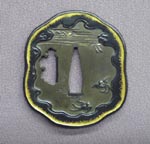 |
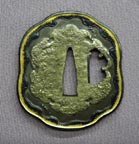 |
| 4) 鐔 桜花に燕図 銘 政景(花押) 縦68.0×横61.0×厚さ3.5 (mm) 政景は洒脱な彫技を工夫し、江戸において一家を成した田中清寿の門人。鉄地の作鐔が多いが、 本作は四分一銀地に赤銅で覆い、金銀色絵を施した素材に凝った入念作。江戸芝住。 江戸時代後期。特別保存鑑定書付。 Design of cherry blossom with flying swallows made by Masakage who is a pupil of Tanaka Kiyotoshi (great metal worker in 19c.) School, was active at Shiba in Edo. Various materials such as gold, silver and Shakudo were used on the Shibuichi (silver alloyed) ground. Flying swallows are depicted skillfully and is a great craftsmanship. 19th century. Tokubetsu Hozon certificate paper. |
|
| 4)鐔 春霞駿馬透図 銘 武州住直正作 Design of a horse with cherry blossoms in spring haze SOLD |
||||||
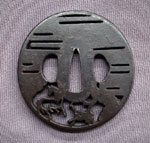 |
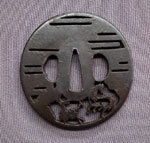 |
|||||
| 4) 鐔 春霞駿馬透図 銘 武州住直正作 寸法:縦73.0×横71.0×厚さ5.0 (mm) 解説:徳川幕府お抱え工、江戸で繁栄した武州伊藤派直正の鉄鐔。透かし技法で、春霞の桜花の下 佇む馬を表現した風情ある好画題。江戸時代後期。保存鑑定書付。 Naomasa who is come from the Ito school in Bushu (around Tokyo area), was active in late Edo period. This school successfully worked for the Tokugawa shogunate, and became popular among the Samurai. A horse and cherry blossom in the spring haze are depicted, can be enjoyed the tasteful of spring. 19c. Hozon certificate paper. |
||||||
| 6) 鐔 桜花蓮華図 Design of cherry blossom of spring scene and lotus flower of highly esteemed plant in Buddhism SOLD |
||||||
 |
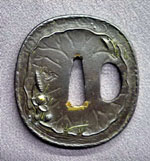 |
|||||
| 6) 鐔 桜花蓮華図 銘 伯竜子寿高(花押) 縦68.0×横63.5×厚さ4.0 (mm) 本作は表に春の華やかさを表わす桜花を、裏に仏教で尊い植物とされている蓮を面一杯に大胆 に表現している。初代寿高の養子である作者は田中清寿の門人であり、明治末まで活躍したと 云われる。江戸時代後期。保存鑑定書付。 Design of cherry blossom of spring scene and lotus flower of highly esteemed plant in Buddhism made by Hakuryushi Toshitaka who is an adopted child of 1st Toshitaka. He became a pupil of Tanaka Kiyotoshi who is a great metal worker in 19c, and was active in Edo until the end of Meiji period. The front of this iron ground depicts cherry blossom, on the back is carved lotus flower. 19c. Hozon certificate paper. |
||||||
| 7)目貫 盛花図 無銘 Design of displaying cherry blossoms on the shallow bowl SOLD |
||||||
|
||||||
| 7) 目貫 盛花図 無銘 寸法:左) 縦12.0×横43.0 (mm) 右) 縦12.5×横42.0 (mm) 解説:赤銅容彫りで、桜の花を花器に盛り付けた上品な図柄。日本刀研究で有名な、 佐藤寒山博士の箱書で、古後藤「珍しき図柄」と記されている。桃山時代。 Design of displaying cherry blossoms on the shallow bowl which was made of Shakudo. It is attributed to Ko-goto by Dr. Sato kanzan who is a famous sword and fittings authority, and he described “This is a rare design” on the attached wood box. It is so elegant and classical work of art by famous Goto family who served Shogun for generations. Circa 1580. Momoyama period. prize of the Minister of the Navy in the filed of making Tsuba during World WarⅡ. |
||||||
| 1) 鐔 桜透図 Design: Cherry blossoms by Katchushi.18c. |
|
 |
 |
| 1) 鐔 桜透図 寸法:縦78.0×横78.0×厚さ2.5 (mm) 解説:薄手の鉄地に桜花文様が透かし彫りにされている。赤銅覆輪のある甲冑師の作品と 思われる。 Design: Cherry blossoms by Katchushi.18c. |
|
| 1) 鐔 立ち雛図 Design: Japanese traditional dolls for ceremony of girls, calledHina-Matsuri. Sold |
|
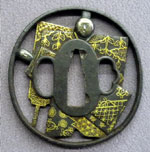 |
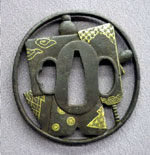 |
| 1) 鐔 立ち雛図 寸法:71.5×横67.5×厚さ5.0 (mm) 解説:立ち雛とは3月3日の上巳の節句(雛祭り)に飾る人形で、立ち姿にこしらえ た男女一対のひな人形のことを言う。 上巳の節句(雛祭り)とは五節句の一つで、女児のある家でひな人形などを飾り祝 う行事。 けがれ、災いを人形に移し祓おうとする風習が起源とされている。 本作は細かい金象嵌で着物の図柄などが裏表に表現されており、御祝い事などに 愛用された品と思われる。江戸時代中期。 Design: Japanese traditional dolls for ceremony of girls, called Hina-Matsuri. Hina-Matsuri is took place on March 3rd for the girls, which is one of the five important ceremony, Nanakusa-no-Sekku (January 7th), Tango-no-Sekku (May 5th), Tanabata-no-Sekku (July 7th),Choyo-no-Sekku (September 9th). On March 3rd, we display the dolls, sweet white sake and peach blossom etc. It has meaning of exorcise the harms from the girls. Elegant designs of Kimono were represented by fine gold inlay on the iron surface. 18th century. |
|
| 6) 七宝繋・紗綾形桜花文 Shippo & cherry design Sold |
|
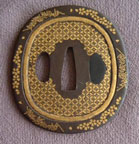 |
|
| 6)七宝繋・紗綾形桜花文 寸法:81.0x74(mm) 鉄地に金布目象嵌 鉄地に布目象嵌を施した肥後系鐔は人気があり、江戸でも作られた。 大振りな本作は金象嵌が華やかで優雅な意匠。 Iron, gold numone inlay.19C. |
|
| 7) 桜花図 The cherry blossom Sold |
|
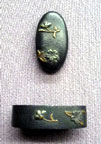 |
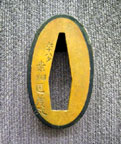 |
| 8) 桜花図 桑原匡義(花押)六十八才 寸法: 縁(Fuchi); 37.0(mm) 赤銅石目地に金・銀象嵌 安永2年(1773)生、鹿児島住。 後藤光美門人。天保11年(1840)の作。 Kuwahara Masayoshi 68 sai Pupil of Goto Mitsuyoshi Shakudo (cupper alloyed), gold and silver inlaidid |
|
| 8) 小柄 桜に繋ぎ駒図 Design of cherry blossoms with a house which is being tied with cherry blossom tree |
|
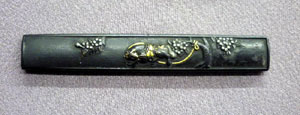 |
|
| 8) 小柄 桜に繋ぎ駒図 縦14.0×横96.5 (mm) 桜の木に鞍を付けられたまま馬が繋がれている。馬主は花見に興じているのか、辺りに見当 らない。この場景は俳句や民謡などでもたびたび詠われている画題で、桜の季節に大人しく主 を待つ馬がなんとも。江戸時代中期。 Design of cherry blossoms with a house which is being tied with cherry blossom tree. A master for the house is nowhere to be found in the design. Probably the master is enjoying the cherry blossoms and drinking. This scene is sung in the Japanese traditional poem and ballad etc. 18h century. |
|